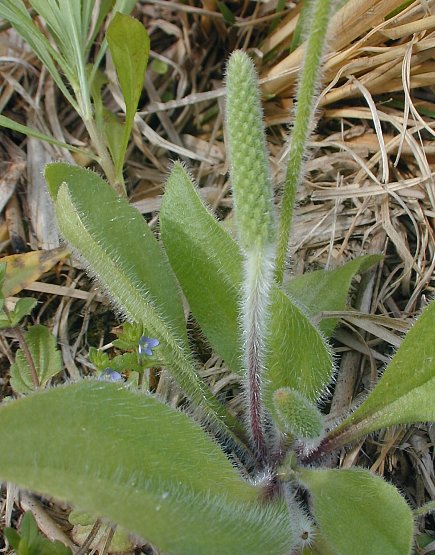Plant: Annual herb; to 34.5 cm tall
Leaves: petiolate; blades lanceolate, 2.5-10 cm long, 0.8-2.7 cm wide, attenuate at base, acute at apex, sparsely villous, distincly 3-veined, sometimes with 2-4 widely-spaced teeth
INFLORESCENCE: pedunculate, scapose; PEDUNCLES 1-20 cm long. SPIKES 1.5-17 cm long, sparsely to densely villous; bracts subulate to narrowly or broadly triangular, 2-4.8 mm long, narrowly scarious-margined at base, ciliate
Flowers: more or less dioecious; sepals ovate, 2.5-3 mm long, broadly scarious-margined, acuminate at apex, obtuse to subacute at base, hirsute only on midrib; corolla lobes erect, enclosing the capsule (sometimes spreading in staminate flowers), lanceolate, 2-3 mm long; stamens 4
Fruit: capsules, breaking at middle; SEEDS 2, ellipsoid, 0.9-3.0 mm long, 0.8-1.6 mm wide, light brown, the inner surface deeply concave, the outer surface furrowed
Misc: Disturbed areas; 450-1300 m (1500-4200 ft.); Mar-Jul
REFERENCES: Huisinga, Kristin D. and Tina J. Ayers. 1999. Plantaginaceae. Ariz. - Nev. Acad. Sci. 32(1).
Annual of biennial herb with a taproot flowering stem to 20 cm tall
Leaves: basal, 5 - 10 cm long, reverse lance-shaped to reverse egg-shaped with a blunt apex, more or less parallel-veined, sometimes inconspicuously toothed, and hairy.
Inflorescence: a dense spike of many flowers, arising from a leafless stalk (scape), 3 - 10 cm long, 6 - 8 mm wide, moderately woolly.
Flowers: stalkless or nearly stalkless, subtended by lance-shaped bracts, not fragrant. Bracts minutely hairy. Stamens four, exserted, alternate with corolla lobes. Style one.
Sepals: four, green, 2 - 2.5 mm long, oblong reverse egg-shaped with a rounded apex, scarious-margined (dry, thin, and membranous), with a minutely hairy keel.
Fruit: a dehiscent capsule (circumscissile). Seeds two, pale brown, 1.3 - 2 mm long, less than half as wide, convex on one side, concave on the other.
Corolla: four-lobed, whitish, scarious (dry, thin, membranous). Lobes upright, 1 - 3 mm long. The corollas of fertile flowers close over the maturing capsule.
Similar species: Plantago media is similar but its corollas do not close over the maturing capsules and the flowers are fragrant.
Flowering: May to early June
Habitat and ecology: Infrequent in the Chicago Region. Found in fallow fields and pastures. Often found in acid sandy soil.
Occurence in the Chicago region: native
Etymology: Plantago comes from the Latin word planta, meaning footprint. Virginica means "of or from Virginia."
Author: The Morton Arboretum
Rare or absent from most of our northern counties, becoming frequent to common in the southern counties. It is found in both dry and moist habitats, but prefers slightly acid, moist soil and is usually found in fallow fields and pastures.
Duration: Annual
Nativity: Native
Lifeform: Forb/Herb
General: Annual herb to 34.5 cm tall.
Leaves: Petiolate, blades lanceolate 2.5-10 cm long, .8-2.7 cm wide, attenuate at base, acute at apex, sparsely villous, distinctly 3-veined, sometimes 2-4 widely-spaced teeth.
Flowers: Peduncles 1-20 cm long, spikes 1.5-17 cm long, sparsely to densely villous, subulate bracts narrowly or broadly triangular, 2-4.8 mm long, narrowly scarious-margined at base, ciliate; more or less dioecious flowers, ovate sepals 2.5-3 mm long, 4 stamens.
Fruits: Capsule breaks at middle.
Ecology: Found in disturbed areas from 1,500-4,500 ft (457-1372 m); flowers March-July.
Distribution: Most states in the U.S. except the northwest; south to s MEX.; also in Asia and Africa.
Notes: This species distinguished by leaves lanceolate, >1 cm wide, acute at the apex and with 2-3 remote, shallow teeth; and corolla lobes strictly erect at maturity, enclosing the capsule. Similar to P. rhodosperma, but otherwise clearly distinguishable.
Ethnobotany: Used ceremonially.
Etymology: Plantago translates to foot-sole in reference to leaf habit on ground, while virginica means Virginia.
Synonyms: Plantago virginica var. viridescens
Editor: SBuckley 2010, FSCoburn 2015
Taprooted, hirsutulous annual or biennial; lvs oblanceolate to obovate, 5-10(-15) cm, obtuse, entire or inconspicuously toothed; scape to 2 dm; spikes 3-10(-20) cm נ6-8 mm; bracts lanceolate, mostly shorter than the cal, hirsutulous, a scarious margin scarcely developed; sep oblong-obovate, rounded above, the keel hirsutulous, the scarious margin broad and glabrous; cor-lobes 1-3 mm, erect and connivent even in fr; seeds 2, 1.3-2 mm, less than half as wide, convex on the back, strongly concave on the inner face, the hilum nearly as long as the seed; 2n=24. Occasional plants have chasmogamous fls with spreading cor-lobes. A spring ephemeral of dry or sandy soil, often weedy; Mass. and N.Y. to Wis., Io., and S.D., s. to Fla. and Tex., and intr. westward.
Gleason, Henry A. & Cronquist, Arthur J. 1991. Manual of vascular plants of northeastern United States and adjacent Canada. lxxv + 910 pp.
©The New York Botanical Garden. All rights reserved. Used by permission.





